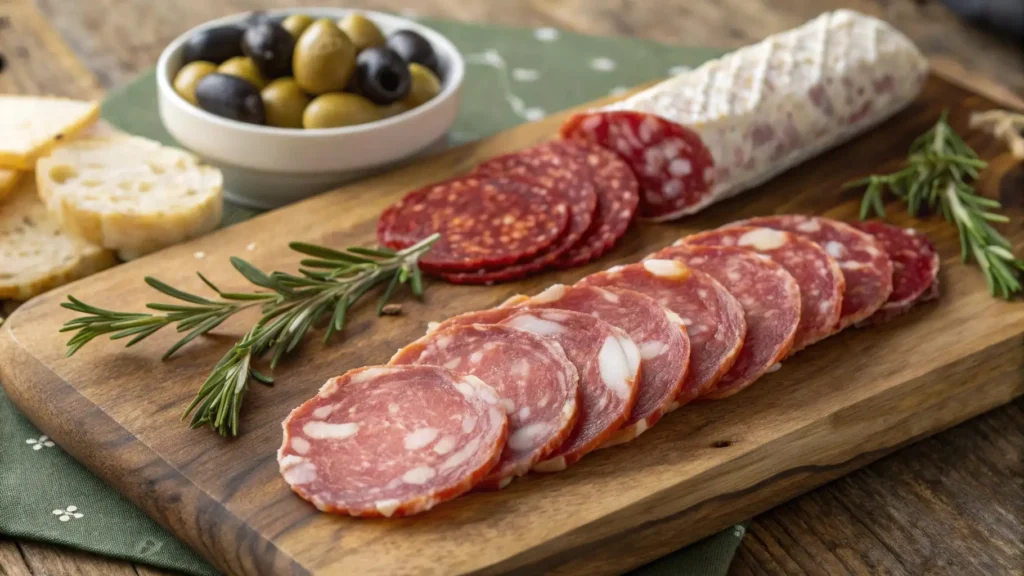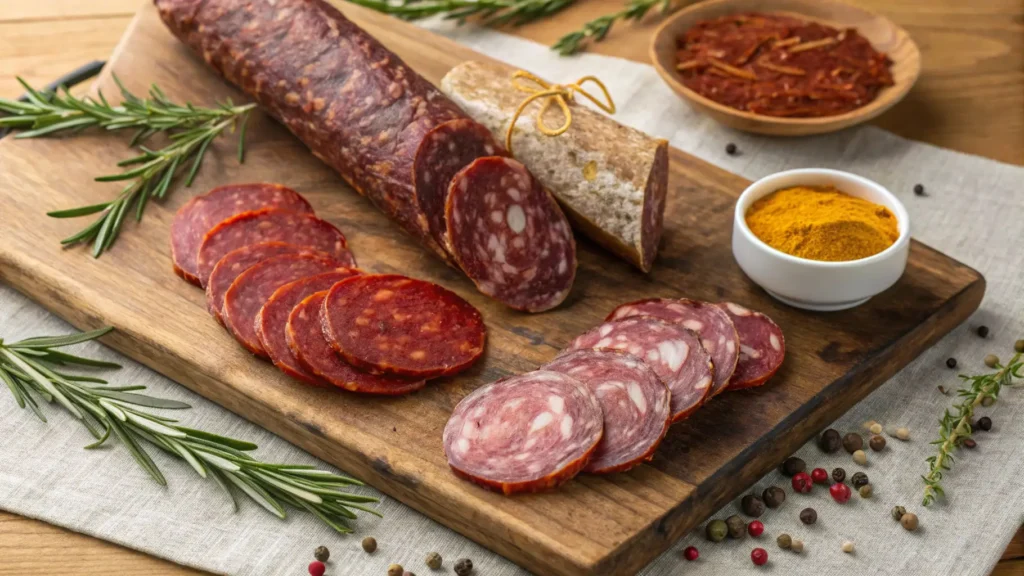Salami and soppressata are two of the most popular cured meats, enjoyed on charcuterie boards, in sandwiches, and as versatile ingredients in countless dishes. While both are savory and delicious, they have distinct differences in flavor, texture, and preparation.

In this guide, we’ll explore the characteristics of salami and soppressata, their unique qualities, and how they differ. Whether you’re a foodie looking to refine your palate or simply curious about these Italian staples, this guide will help you better understand and appreciate their individual merits.
Overview of Salami
It’s a type of cured sausage made from fermented and air-dried meat, traditionally pork but sometimes including beef or other meats. Its origins trace back to Italy, but its popularity has spread globally, resulting in many regional variations. Salami is known for its firm texture, tangy flavor, and versatility.
The meat is finely ground, mixed with spices like garlic, black pepper, and fennel, and then stuffed into casings before being cured and dried. The process creates a salami with a consistent texture and a balanced blend of flavors.
Varieties of Salami Across the World
Salami takes many forms depending on the region and local ingredients. A few popular varieties include:

- Salami is a globally cherished cured meat, with each region offering its own unique flavors, seasonings, and preparation methods. Here are some of the most well-known varieties:
- Genoa Salami – A classic Italian variety, known for its smooth, tender texture and mild, slightly tangy flavor. Made primarily from pork, garlic, wine, and black pepper, it is often air-dried and aged to develop its signature richness.
- Spanish Chorizo – This bold, smoky salami is made with coarsely ground pork and seasoned with paprika, garlic, and salt, giving it a deep red color and a slightly spicy kick. Depending on the region, chorizo can be either dry-cured (ready to eat) or semi-cured (requiring cooking).
- Hungarian Salami – A staple in Hungary, this variety is heavily seasoned with paprika, white pepper, and garlic, giving it a distinct smoky, slightly spicy flavor. It is typically cold-smoked and aged for weeks to develop a firm yet rich and flavorful texture.
- French Saucisson – A dry-cured French salami with a rustic, coarse texture and a delicate balance of herbal and peppery flavors. Often made with pork, wine, and natural seasonings, saucisson sec is a popular addition to charcuterie boards and French appetizers.
Each variety has its own distinct characteristics, reflecting the cultural and culinary traditions of its origin.
What Is Soppressata?
Overview of Soppressata
Soppressata, another Italian cured meat, stands out for its rustic and coarse texture. Unlike salami, which is finely ground, soppressata uses hand-cut or roughly ground meat, giving it a heartier bite. It is often seasoned with bold spices such as chili flakes or fennel seeds, depending on regional preferences.
Soppressata’s name comes from the Italian word soppressare, meaning “to press,” referencing the shaping process that gives this its characteristic flattened appearance. Traditionally made from pork, some versions include beef or a mix of meats.
Regional Varieties in Italy
Soppressata varies widely across Italy, with notable examples including:
- Soppressata di Calabria DOP – This bold, spicy variety hails from Calabria and is known for its fiery kick, thanks to chili peppers and high-quality pork cuts. It has a deep red color and an intensely rich flavor, making it a standout in Italian cured meats.
- Soppressata di Puglia – A milder, more delicate version, typically seasoned with black pepper and aromatic herbs. This variety has a smoother texture and a well-balanced, subtly spiced taste, making it versatile for various dishes.
- Soppressata Toscana – A rustic, coarsely textured soppressata made with offcuts and fat, giving it a heartier, more traditional feel. It is heavily seasoned with garlic, spices, and black pepper, creating a bold, savory bite that pairs well with crusty bread and cheeses.
These regional differences highlight the diversity of Italian cured meats and how local traditions shape their production.
Key Differences Between Salami and Soppressata
Texture and Appearance
One of the most noticeable differences lies in the texture and appearance of these cured meats:
- Salami: Finely ground meat creates a smooth, uniform texture. It has a round, cylindrical shape and firm consistency, making it easy to slice thinly.
- Soppressata: Coarsely ground or hand-cut meat results in a rustic, chunky texture. Its flattened, irregular shape distinguishes it from the cylindrical form of salami, giving it a more artisanal look.
Flavor Profiles
The flavor profiles of these meats also set them apart:
- Salami – Known for its balanced, tangy flavor, thanks to its fermentation process. The taste is enhanced by subtle spices like garlic and black pepper, while regional variations may introduce smoky, sweet, or herbal notes, depending on local curing traditions.
- Soppressata – This variety offers a bolder, more intense flavor, with robust seasoning that varies by type. Spicy versions include chili flakes or hot peppers, delivering a fiery kick, while sweeter variations highlight the rich, natural taste of pork complemented by aromatic spices like fennel seeds.
Soppressata generally has a more intense flavor, making it a favorite for those who enjoy bold, savory cured meats.
Preparation and Ingredients
The methods and ingredients used in their preparation also highlight their differences:
- Salami: Typically made with finely ground pork or a combination of meats. Producers ferment the meat mixture to develop its tangy taste before curing and drying it.
- Soppressata: Uses hand-cut or coarsely ground pork, sometimes blended with beef. It undergoes curing and pressing, which gives it its characteristic flattened shape and concentrated flavor.
The seasoning in soppressata tends to be more pronounced, while salami often features a milder, more uniform taste.
Culinary Uses and Pairings
How to Use Salami in Recipes
Its versatility makes it a staple in many dishes, from casual snacks to elaborate meals:

- Charcuterie Boards – A must-have for any charcuterie spread, salami pairs beautifully with cheeses like Gouda, Brie, or aged Parmesan, along with fresh fruits, olives, and crusty bread.
- Sandwiches & Paninis – With its firm texture and well-balanced flavor, salami is an excellent addition to deli sandwiches, paninis, and wraps. Pair it with mustard, pickles, and arugula for an extra kick.
- Pizza Topping – Thin slices of salami crisp up beautifully in the oven, adding a savory, tangy depth to any pizza. Try it with mozzarella, olives, and hot honey for a bold twist.
- Salads – Dice salami into bite-sized pieces to add protein and a burst of flavor to pasta salads or fresh green salads. It pairs especially well with Mediterranean ingredients like olives, feta, and sun-dried tomatoes.
Salami’s subtle tang and mild seasoning make it easy to pair with a variety of ingredients and dishes.
Soppressata in Culinary Applications
Soppressata’s bold flavor and rustic texture make it a standout ingredient for heartier dishes:
- Charcuterie Boards: Its coarse texture and intense seasoning shine when paired with robust cheeses like Pecorino Romano or sharp cheddar, along with olives or figs.
- Pasta Dishes: Add diced or sliced soppressata to pasta recipes with olive oil, garlic, and crushed red pepper for an elevated dish.
- Sandwiches: Use it in paninis or subs for a spicy, flavorful kick that complements creamy or tangy spreads.
- Egg Dishes: Incorporate chopped soppressata into omelets, frittatas, or scrambled eggs for a savory breakfast.
With its bold flavors, soppressata is best paired with rich, hearty dishes or served on its own to let its taste take center stage.
Frequently Asked Questions (FAQs)
Is soppressata a type of salami?
Yes, soppressata is a type of salami. However, its preparation, texture, and seasoning set it apart from standard varieties.
Which is spicier, salami or soppressata?
Soppressata is often spicier, especially in versions from Calabria, which use chili flakes or hot peppers.
Can I substitute soppressata for salami in recipes?
Yes, but be mindful of the flavor differences. Soppressata’s bold, spicy taste may overpower dishes where milder salami works better.
Which is healthier, salami or soppressata?
Nutritional differences depend on the specific preparation, but soppressata often contains more fat due to its coarse cuts and seasoning. Both should be enjoyed in moderation as part of a balanced diet.
What drinks pair best with these meats?
- Salami: Pairs well with red wines like Chianti or lighter options like Pinot Noir. Beers such as lagers or pilsners also complement salami’s tangy flavor.
- Soppressata: Bold red wines like Zinfandel or Malbec enhance its robust taste, while sweeter wines like Lambrusco balance its spicy varieties.
Conclusion
While salami and soppressata share a common heritage, their differences in texture, flavor, and preparation make each unique. Salami’s balanced tang and smooth texture make it a versatile option, while soppressata’s bold seasoning and rustic character cater to those seeking more intensity.
Choosing between the two depends on your dish and flavor preferences, but both are excellent choices for charcuterie boards, recipes, or standalone snacks. Whether you enjoy the mild elegance of salami or the hearty punch of soppressata, these Italian cured meats deliver delicious versatility.
For more inspiration, check out our guide to Delicious Baked Ziti Recipe (No Meat) or explore pairing ideas with WhatSauce Goes on Salmon?.
